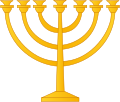
Back Kabbala Afrikaans Kabbala GSW قبالة (يهودية) Arabic كابالا ARZ Kabbala Azerbaijani Kabbalah BAR Кабала Byelorussian Кабала BE-TARASK Кабала Bulgarian কাব্বালাহ্ Bengali/Bangla

| Part of a series on |
| Kabbalah |
|---|
 |
| Part of a series on |
| Judaism |
|---|
  |
| Part of a series on |
| Esotericism |
|---|
 |
Kabbalah or Qabalah (/kəˈbɑːlə, ˈkæbələ/ kə-BAH-lə, KAB-ə-lə; Hebrew: קַבָּלָה, romanized: Qabbālā, pronounced [kabaˈla] ⓘ; lit. 'reception, tradition')[1][a] is an esoteric method, discipline and school of thought in Jewish mysticism.[2] It forms the foundation of mystical religious interpretations within Judaism.[2][3] A traditional Kabbalist is called a Mekubbal (מְקֻובָּל, Məqubbāl, 'receiver').[2]
Jewish Kabbalists originally developed transmissions of the primary texts of Kabbalah within the realm of Jewish tradition[2][3] and often use classical Jewish scriptures to explain and demonstrate its mystical teachings. Kabbalists hold these teachings to define the inner meaning of both the Hebrew Bible and traditional rabbinic literature and their formerly concealed transmitted dimension, as well as to explain the significance of Jewish religious observances.[4]
Historically, Kabbalah emerged from earlier forms of Jewish mysticism, in 12th- to 13th-century Hakhmei Provence (re:Bahir), Rhineland school of Judah the Pious,[5] al-Andalus (re: Zohar)[2][3] and was reinterpreted during the Jewish mystical renaissance in 16th-century Ottoman Palestine.[2] The Zohar, the foundational text of Kabbalah, was authored in the late 13th century, likely by Moses de León. Isaac Luria (16th century) is considered the father of contemporary Kabbalah; Lurianic Kabbalah was popularised in the form of Hasidic Judaism from the 18th century onwards.[2] During the 20th century, academic interest in Kabbalistic texts led primarily by the Jewish historian Gershom Scholem has inspired the development of historical research on Kabbalah in the field of Judaic studies.[6][7]
Though minor works contribute to an understanding of the Kabbalah as an evolving tradition, the primary texts of the major lineage in medieval Jewish tradition are the Bahir, Zohar, Pardes Rimonim, and Etz Chayim ('Ein Sof').[8] The early Hekhalot literature is acknowledged as ancestral to the sensibilities of this later flowering of the Kabbalah[9] and more especially the Sefer Yetzirah is acknowledged as the antecedent from which all these books draw many of their formal inspirations. The document has striking similarities to a possible antecedent from the Lesser Hekhalot, the Alphabet of Rabbi Akiva, which in turn seems to recall a style of responsa by students that arose in the classroom of Joshua ben-Levi in Tractate Shabbat.[10] The Sefer Yetzirah is a brief document of only a few pages that was written many centuries before the high and late medieval works (sometime between 200-600CE), detailing an alphanumeric vision of cosmology and may be understood as a kind of prelude to the major phase of Kabbalah.[8]
- ^ "קַבָּלָה". /www.morfix.co.il. Melingo Ltd. Archived from the original on 26 March 2016. Retrieved 19 November 2014.
- ^ a b c d e f g Ginzberg, Louis; Kohler, Kaufmann (1906). "Cabala". Jewish Encyclopedia. Kopelman Foundation. Archived from the original on 4 November 2011. Retrieved 23 October 2018.
- ^ a b c Dennis, Geoffrey W. (18 June 2014). "What is Kabbalah?". ReformJudaism.org. Union for Reform Judaism. Archived from the original on 25 April 2015. Retrieved 25 October 2018.
Historians of Judaism identify many schools of Jewish esotericism across time, each with its own unique interests and beliefs. Technically, the term "Kabbalah" applies only to writings that emerged in medieval Spain and southern France beginning in the 13th century. [...] Although until today Kabbalah has been the practice of select Jewish "circles," most of what we know about it comes from the many literary works that have been recognized as "mystical" or "esoteric." From these mystical works, scholars have identified many distinctive mystical schools, including the Hechalot mystics, the German Pietists, the Zoharic Kabbalah, the ecstatic school of Abraham Abulafia, the teachings of Isaac Luria, and Chasidism. These schools can be categorized further based on individual masters and their disciples.
- ^ "Imbued with Holiness" Archived 2010-10-12 at the Wayback Machine – The relationship of the esoteric to the exoteric in the fourfold Pardes interpretation of Torah and existence. From www.kabbalaonline.org
- ^ See works by Eleazar of Worms (eg. his gloss on Sefer Raziel), Judah of Regensburg et. al. Especially important in the development of Notarikon. For Trachtenberg, the Kabbalah’s medieval European phase really begins here (implying the Bahir is reproduced in Provence from elsewhere), but most follow Scholem and other scholars on this question locating the Bahir in Provence as the root of this phase.
- ^ Huss, Boaz; Pasi, Marco; Stuckrad, Kocku von, eds. (2010). "Introduction". Kabbalah and Modernity: Interpretations, Transformations, Adaptations. Leiden: Brill Publishers. pp. 1–12. ISBN 978-90-04-18284-4.
- ^ Magid, Shaul (Summer 2014). "Gershom Scholem". In Edward N. Zalta (ed.). Stanford Encyclopedia of Philosophy. Center for the Study of Language and Information. Archived from the original on 13 February 2023. Retrieved 23 October 2018.
- ^ a b Scholem (1995).
- ^ Scholem (1960); Scholem (1995).
- ^ Shabbat 104a
Cite error: There are <ref group=lower-alpha> tags or {{efn}} templates on this page, but the references will not show without a {{reflist|group=lower-alpha}} template or {{notelist}} template (see the help page).